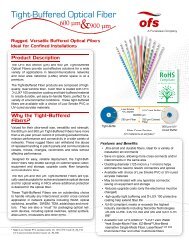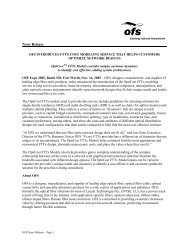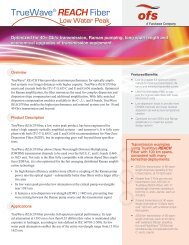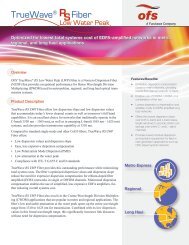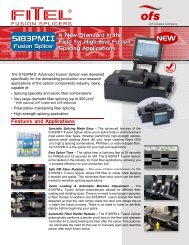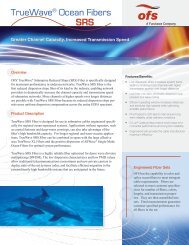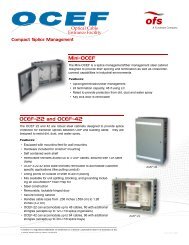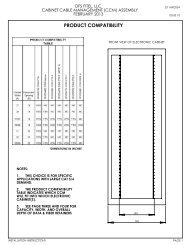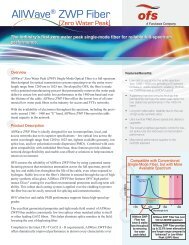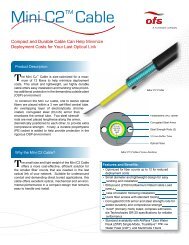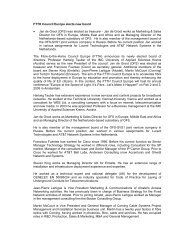BICSI News Magazine - OFS
BICSI News Magazine - OFS
BICSI News Magazine - OFS
Create successful ePaper yourself
Turn your PDF publications into a flip-book with our unique Google optimized e-Paper software.
As the demand for bandwidth in enterprise applications<br />
like data centers continues to boom, new transmission<br />
media must be continually developed to meet end user<br />
requirements. The latest in optical transmission media for<br />
the enterprise is called OM4 optical fiber.<br />
&technology<br />
innovation<br />
OM4 is a 50 micrometer (μm) laseroptimized<br />
multimode optical fiber with<br />
extended bandwidth. It will be used to<br />
enhance the system cost benefits enabled<br />
by 850 nanometer (nm) vertical cavity<br />
surface emitting lasers (VCSELs) for<br />
existing 1 and 10 gigabit per second (Gb/s)<br />
applications as well as future 40 and 100<br />
Gb/s systems. Supporting Ethernet, Fibre<br />
Channel and Optical Internetworking<br />
Forum (OIF) applications, OM4 fiber<br />
allows extended reach upward of 550<br />
meters (m [1804 feet (ft)]) at 10 Gb/s for<br />
ultralong building backbones and medium<br />
length campus backbones. It offers an<br />
effective modal bandwidth (EMB) of 4700<br />
megahertz kilometer (MHz•km), more<br />
than double the IEEE requirement for<br />
10 Gb/s 300 m (984 ft) support.<br />
To help you use this advanced optical<br />
fiber to its greatest advantage, this article<br />
describes the technology behind OM4,<br />
highlights the key differences with other<br />
optical fiber types and explains how<br />
its high bandwidth is ensured through<br />
stringent measurement methods.<br />
Multimode Fundamentals<br />
Compared with singlemode optical<br />
fibers, multimode optical fibers have<br />
larger cores that, as their name implies,<br />
guide multiple “modes” or rays of light<br />
simultaneously (see Figure 1). Modes that<br />
travel at the outside edge of the core have<br />
a longer distance to go than modes that<br />
travel near the center of the core.<br />
The core’s graded index profile is<br />
designed to slow down modes that have<br />
a shorter distance to travel so that all<br />
modes arrive at the end of the fiber as<br />
close in time as possible. This minimizes<br />
modal dispersion, also known as differential<br />
mode delay (DMD), and maximizes bandwidth,<br />
which is the amount of information<br />
that can travel through the fiber per unit<br />
of time.<br />
In addition to their large core,<br />
multimode optical fibers have a large<br />
numerical aperture (NA), the maximum<br />
angle at which an optical fiber can accept<br />
the light that will be transmitted through<br />
it. This allows them to work with relatively<br />
low-cost optical components and light<br />
sources such as light-emitting diodes (LEDs)<br />
and VCSELs.<br />
OM4 fiber is also<br />
available in a bendoptimized<br />
design.<br />
These fibers offer all<br />
the advantages of highbandwidth<br />
multimode<br />
fiber with the added<br />
advantage of lower<br />
bend sensitivity.<br />
Tony Irujo is a sales engineer<br />
for <strong>OFS</strong> where he provides<br />
technical sales and marketing<br />
support for multimode and<br />
singlemode optical fiber. He<br />
has 25 years experience in<br />
optical fiber manufacturing,<br />
testing and applications and<br />
can be reached at tirujo@<br />
ofsoptics.com.<br />
Electronic reprint with permission from <strong>BICSI</strong> <strong>News</strong> <strong>Magazine</strong>-May/June 2010 Issue



